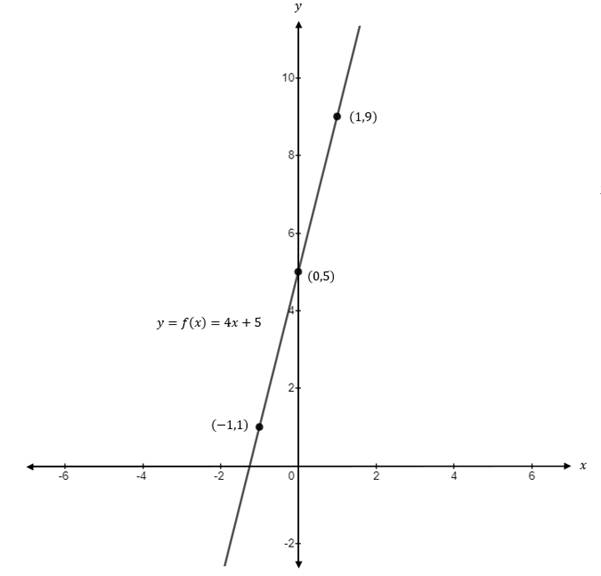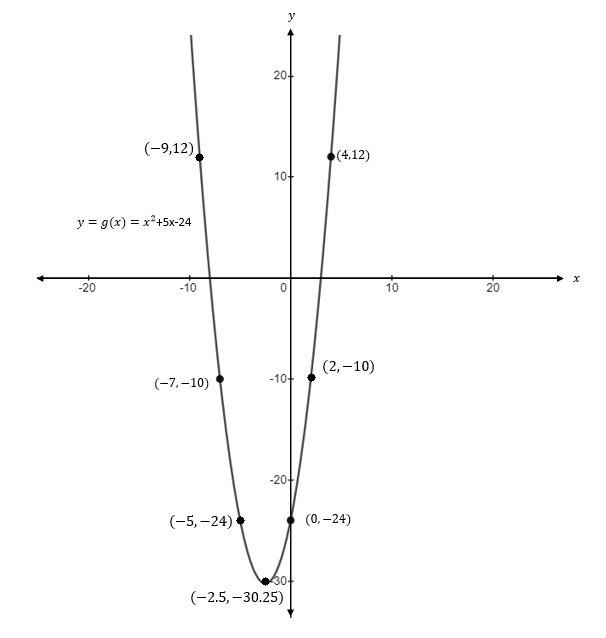
(a)
The solution of the equation
(a)
Answer to Problem 14CR
Solution:
The solution for the equation
Explanation of Solution
Given information:
The function
Consider the equation
Substitute
Subtract
Divide both sides by
Therefore, solution of
(b)
The solution of the equation
(b)
Answer to Problem 14CR
Solution:
The solution for the equation
Explanation of Solution
Given information:
The function
Consider the equation
Substitute
Subtract
Divide both sides by
Therefore, solution of
(c)
To calculate: The solution of the equation
(c)
Answer to Problem 14CR
Solution:
The solution set for the equation
Explanation of Solution
Given information:
The functions
Formula used:
Quadratic formula for the zeros of the
Calculation:
Consider the equation
Solving
Now,
By the quadratic formula, the zeros of the quadratic equation
Thus, the solution set for the equation
(d)
The solution of the inequality
(d)
Answer to Problem 14CR
Solution:
The inequality
Explanation of Solution
Given information:
The function
Consider the inequality
Subtract
Divide the above inequality by
Therefore, the inequality
(e)
To calculate: The solution of the inequality
(e)
Answer to Problem 14CR
Solution:
The inequality
Explanation of Solution
Given information:
The function
Consider the inequality
Substitute
Factor out the above term
From the above, the zeroes of
Form intervals using zeroes
The interval
To check the inequality at end points.
Substitute
Inequality holds at
Substitute
Inequality holds at
Therefore, the solution for
(f)
To graph: The function
(f)
Explanation of Solution
Given information:
The function
Graph:
To graph the function
Draw these points on a graph and pass a line through these points.
The graph of

Interpretation:
The graph represents function of
(g)
To graph: The function
(g)
Explanation of Solution
Given information:
The function
Graph:
Consider the function
The standard equation
By comparing with standard equation
The equation has vertex at
Also, find some points satisfying equation of function.
Draw these points on a graph and pass a curve through these points.
The graph of

Interpretation:
The graph represents the function
Chapter 8 Solutions
Precalculus Enhanced with Graphing Utilities
Additional Math Textbook Solutions
College Algebra (7th Edition)
Calculus: Early Transcendentals (2nd Edition)
Elementary Statistics
Elementary Statistics: Picturing the World (7th Edition)
Algebra and Trigonometry (6th Edition)
Basic Business Statistics, Student Value Edition
- r>0 (r, 0) = T 0 and one with r 0 2 (c) (9,-17) 3 (r, 8) (r, 8) r> 0 r<0 (r, 0) = (r, 8) = X X X x x Warrow_forward74. Geometry of implicit differentiation Suppose x and y are related 0. Interpret the solution of this equa- by the equation F(x, y) = tion as the set of points (x, y) that lie on the intersection of the F(x, y) with the xy-plane (z = 0). surface Z = a. Make a sketch of a surface and its intersection with the xy-plane. Give a geometric interpretation of the result that dy dx = Fx F χ y b. Explain geometrically what happens at points where F = 0. yarrow_forwardExample 3.2. Solve the following boundary value problem by ADM (Adomian decomposition) method with the boundary conditions მი მი z- = 2x²+3 дг Əz w(x, 0) = x² - 3x, θω (x, 0) = i(2x+3). ayarrow_forward
- 6. A particle moves according to a law of motion s(t) = t3-12t2 + 36t, where t is measured in seconds and s is in feet. (a) What is the velocity at time t? (b) What is the velocity after 3 s? (c) When is the particle at rest? (d) When is the particle moving in the positive direction? (e) What is the acceleration at time t? (f) What is the acceleration after 3 s?arrow_forwardConstruct a table and find the indicated limit. √√x+2 If h(x) = then find lim h(x). X-8 X-8 Complete the table below. X 7.9 h(x) 7.99 7.999 8.001 8.01 8.1 (Type integers or decimals rounded to four decimal places as needed.)arrow_forwardUse the graph to find the following limits. (a) lim f(x) (b) lim f(x) X-1 x→1 (a) Find lim f(x) or state that it does not exist. Select the correct choice X-1 below and, if necessary, fill in the answer box within your choice. OA. lim f(x) = X-1 (Round to the nearest integer as needed.) OB. The limit does not exist. Qarrow_forward
- Officials in a certain region tend to raise the sales tax in years in which the state faces a budget deficit and then cut the tax when the state has a surplus. The graph shows the region's sales tax in recent years. Let T(x) represent the sales tax per dollar spent in year x. Find the desired limits and values, if they exist. Note that '01 represents 2001. Complete parts (a) through (e). Tax (in cents) T(X)4 8.5 8- OA. lim T(x)= cent(s) X-2007 (Type an integer or a decimal.) OB. The limit does not exist and is neither ∞ nor - ∞. Garrow_forwardDecide from the graph whether each limit exists. If a limit exists, estimate its value. (a) lim F(x) X➡-7 (b) lim F(x) X-2 (a) What is the value of the limit? Select the correct choice below and, if necessary, fill in the answer box within your choice. OA. lim F(x) = X-7 (Round to the nearest integer as needed.) OB. The limit does not exist. 17 Garrow_forwardFin lir X- a= (Us -10 OT Af(x) -10- 10arrow_forward
- Find all values x = a where the function is discontinuous. For each value of x, give the limit of the function as x approaches a. Be sure to note when the limit doesn't exist. f(x)=4x²+7x+1 Select the correct choice below and, if necessary, fill in the answer box(es) to complete your choice. (Use a comma to separate answers as needed.) OA. f is discontinuous at the single value x = B. f is discontinuous at the single value x = OC. f is discontinuous at the two values x = OD. fis discontinuous at the two values x = OE. f is discontinuous at the two values x = The limit is The limit does not exist and is not co or - oo. The limit for the smaller value is The limit for the larger value is The limit for both values do not exist and are not co or - co. The limit for the smaller value does not exist and is not oo or - co. The limit for the larger value isarrow_forwardFind all values x = a where the function is discontinuous. For each value of x, give the limit of the function as x approaches a. Be sure to note when the limit doesn't exist. 8+x f(x) = x(x-1) (Use a comma to separate answers as needed.) OA. The function f is discontinuous at the single value x = OB. The function f is discontinuous at the single value x = OC. The function f is discontinuous at the two values x = OD. The function f is discontinuous at the two values x = not oo or -0. OE. The function f is discontinuous at the two values x = The limit is The limit does not exist and is not oo or - co. The limits for both values do not exist and are not co or - co. The limit for the smaller value is The limit for the larger value does not exist and is The limit for the smaller value does not exist and is not co or - co. The limit for the largerarrow_forwardi need help please . and please dont use chat gpt i am trying to learn and see the mistake i did when solving minearrow_forward
 Calculus: Early TranscendentalsCalculusISBN:9781285741550Author:James StewartPublisher:Cengage Learning
Calculus: Early TranscendentalsCalculusISBN:9781285741550Author:James StewartPublisher:Cengage Learning Thomas' Calculus (14th Edition)CalculusISBN:9780134438986Author:Joel R. Hass, Christopher E. Heil, Maurice D. WeirPublisher:PEARSON
Thomas' Calculus (14th Edition)CalculusISBN:9780134438986Author:Joel R. Hass, Christopher E. Heil, Maurice D. WeirPublisher:PEARSON Calculus: Early Transcendentals (3rd Edition)CalculusISBN:9780134763644Author:William L. Briggs, Lyle Cochran, Bernard Gillett, Eric SchulzPublisher:PEARSON
Calculus: Early Transcendentals (3rd Edition)CalculusISBN:9780134763644Author:William L. Briggs, Lyle Cochran, Bernard Gillett, Eric SchulzPublisher:PEARSON Calculus: Early TranscendentalsCalculusISBN:9781319050740Author:Jon Rogawski, Colin Adams, Robert FranzosaPublisher:W. H. Freeman
Calculus: Early TranscendentalsCalculusISBN:9781319050740Author:Jon Rogawski, Colin Adams, Robert FranzosaPublisher:W. H. Freeman
 Calculus: Early Transcendental FunctionsCalculusISBN:9781337552516Author:Ron Larson, Bruce H. EdwardsPublisher:Cengage Learning
Calculus: Early Transcendental FunctionsCalculusISBN:9781337552516Author:Ron Larson, Bruce H. EdwardsPublisher:Cengage Learning





